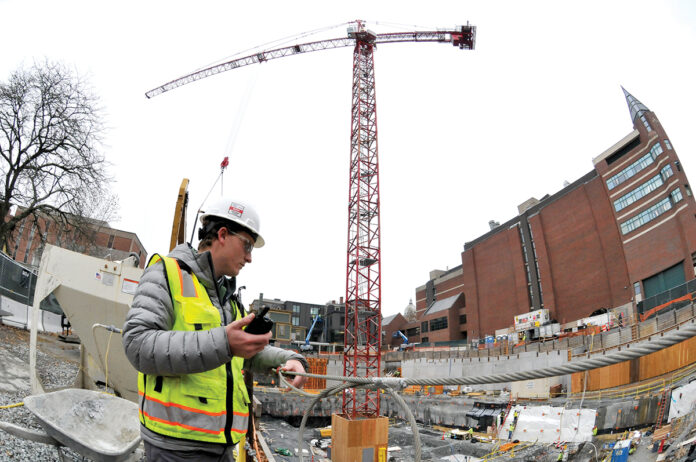As an economic indicator, tower cranes aren’t on the same level as gross domestic product and the consumer price index.
But they can make an impressive statement. The appearance of towering aerial cranes silently lifting and positioning beams for new construction sends a message of growth.
After a dearth of cranes in the sky for years, Providence has had several in the past two years. The most recent imposing visitor is at Brown University. For the next 14 months, the Potain Model MD 509, owned by Pennsylvania-based Maxim Crane Works LP, will be a fixture on College Hill.
The 265,000-pound crane installed over a long weekend in November will build the university’s new Performing Arts Center. It is fixed securely: its base will become the building foundation. Its arm is designed to swivel in the wind, so it can remain in place through Rhode Island’s winter storms.
The new building will rise between Angell and Olive streets. It will cover 94,000 square feet, providing modern rehearsal and performance space to students and faculty.
Construction manager Shawmut Design and Construction, which is overseeing the performing arts center project, determined with the project team that a tower crane was the most effective solution given the confines of the site, said Peter L’Hommedieu, Shawmut senior project manager.
‘A crane has a very warm place in tradesmen and tradeswomen’s hearts.’
MICHAEL SABITONI, Rhode Island Building & Construction Trades Council president
The crane arrived in 24 pieces on four tractor-trailers. It’s a first for Brown University, according to the project manager. In a Nov. 21 time-lapse video, posted to the Shawmut Facebook page, the deliberate assembly of the 257-foot crane plays out in a few minutes. Now in position, it stands 227 feet above ground – or nearly 21 stories – and its base is 30 feet below street grade.
Decorated in festive green lights, it’s visible across the city. A more standard crawler crane, which can move around, would have disrupted the traffic flow on adjacent streets, L’Hommedieu said. The tower crane, by comparison, is installed as part of the building, and moves up as the building is constructed.
“We can access all directions of the site,” L’Hommedieu said. “Then we will potentially use it for a portion of our façade installation and then we will demobilize it and pull it out of the center of the building.”
As a profession, operators of large cranes are highly trained and in-demand.
Jim White, president and business manager for Local 57 of the International Union of Operating Engineers, which represents heavy machinery operators in Rhode Island, said about 60 to 80 people have the required certifications and training. In operating a tower crane, workers get paid extra based on the size of the boom, or the height, because the bigger the boom, the harder it is to operate. Crane operators start working earlier than others on the same job because it takes 25 to 30 minutes to climb the ladder, he said.
The job requires steady nerves, due to the heights and movement of the apparatus. When the wind blows, the tower moves. “You can feel it moving around in the wind,” White said.
As a symbol, the tower or aerial crane is powerful.
Some publications track their appearances as a de-facto gauge of construction. The Toronto-based Rider Levett Bucknall commercial real estate firm created a North American Crane Index several years ago, as a biannual barometer of construction activity.
The index tracks the number of fixed cranes on construction sites in large cities in Canada and the U.S. Its most recent summary, issued in July, found Boston continued to be a strong market. Its activity is mostly taking place in the Seaport District, and residential construction is the sector leading the way.
Seattle and Los Angeles led the pack, accounting for more than half of the total cranes.
Providence is too small to show up on the survey. But the capital city has had its share of aerial workers.
Earlier in the year, a tower crane was used in the construction of the apartment and retail building The Edge, at the base of College Hill. Another was assembled to help build the Nightingale, another mixed-use structure, on Fountain Street.
The other major project underway in Providence – the construction of a new Routes 6-10 connector – is using a series of shorter cranes that are also capable of lifting tons of material.
“The bigger the weight, the bigger the crane,” said Michael Sabitoni, president of the Rhode Island Building & Construction Trades Council.
The cranes illustrate the state of Rhode Island’s economy, he said, and the health of construction in general. Although construction trades are active in many different forms of building, the sight of multiple cranes immediately leaves an impression.
“When you do come into a metropolis, and you see multiple cranes in the sky, whether you’re in construction or not, you just assume progress and economic activity because you can see something getting built,” Sabitoni said. “A crane has a very warm place in tradesmen and tradeswomen’s hearts, and even economists. Because it means progress. It’s a symbolic piece of equipment that something new is happening.”
Mary MacDonald is a PBN staff writer. Contact her at Macdonald@PBN.com.












